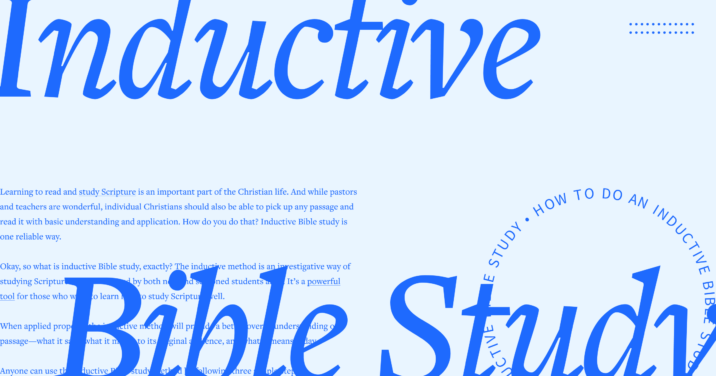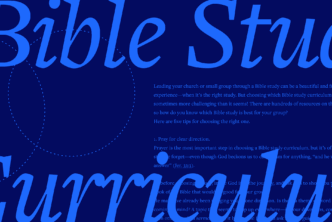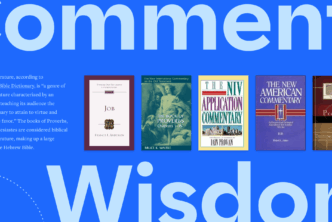Learning to read and study Scripture is an important part of the Christian life. And while pastors and teachers are essential gifts of Christ to his church, individual Christians should also be able to pick up any passage and read it with basic understanding and application. How do you do that? The inductive Bible study method is one reliable way.
What is inductive Bible study, exactly?
The inductive method is an investigative way of studying Scripture that can be used by new and seasoned students alike. It’s a powerful tool for those who want to learn how to study Scripture well.
When applied properly, the inductive method will provide a better overall understanding of a passage:
- What it says
- What it meant to its original audience
- What it means today
Anyone can use the inductive Bible study method by following three simple steps:
- Observation
- Interpretation
- Application
However, since the main goal of inductive Bible study is careful observation that leads to real-life application, I’m going to break the steps down a bit further below.
Table of contents
- What is inductive Bible study, exactly?
- Step 1. Pray: What is the proper spirit for Bible study?
- Step 2. Read: What’s the big picture?
- Step 3. Observe: What does it say?
- Step 4. Interpret: What does it mean?
- Step 5. Discern: What’s the truth?
- Step 6. Apply: What do I do now?
- Step 7. Confess: Who can hold me to these truths?
- Resources for further study
- How to do an inductive Bible study using Logos
- Conclusion
Step 1. Pray: What is the proper spirit for Bible study?
Ask for the Holy Spirit to open your eyes to understand the word. Don’t read it in the flesh. Attitude is critical in understanding the Bible. It can either hinder us or help us in studying the Word. I would encourage you to pray before, during, and after your study. Pray for preparation, illumination, and proper application.
Failing to approach Scripture with the right frequency or intent can undermine the Bible’s power in our lives.
3 ways we undermine the Bible’s power in our lives
- Neglecting to read it
- Reading it without relying on the Spirit’s power to help us understand it
- Reading it, but not obeying what we read
Faulty attitudes
The following attitudes will hinder studying Scripture well. If your attitude about Scripture is represented in one of these four categories below, begin by asking the Holy Spirit to change your heart.
1. The Defeated
I won’t be able to understand anything anyway, so why try to study the Bible?
2. The Negative
I would like to learn how to study the Bible better, but I doubt if anything I discover would be good or right.
3. The Closed Heart
I don’t believe everything the Bible teaches. How can it have any value today? So, why study it?
4. The Lazy
I suppose if I tried I could understand, but what I read seems dull and hard. I don’t know if I want to invest the energy to learn how to study.
Positive attitudes
On the flip side, here are some helpful attitudes you could work to adopt as you approach Scripture:
1. The Positive
I want to learn how to study the Bible. I am sure there will be things in the Bible I won’t understand, but through the help of the Holy Spirit, I can learn to gain insight into God’s word.
2. The Receptive
God asks of me only an open heart and an open mind so he can reveal himself and his truths to me.
3. The Expectant
I’m coming to God’s Word to let him speak to me. I don’t have to inject ideas into my reading or try to squeeze truths out of it that aren’t there. As I study and pray, I believe that the Scripture passage will unfold itself to me.
4. The Faithful
I cannot expect much from Bible study unless I’m willing to invest energy and discipline in the study. If I only scratch the surface, my reward is a few crumbs. If I dig deeply, my reward will be rich treasures.1
Step 2. Read: What’s the big picture?
Read through the whole book you’ve chosen—Genesis, Romans, Colossians, James—at least three times to get the big picture. It’s important to get main ideas and themes down before you get into the specifics of smaller sections. Find the author, recipients, purpose of the book, the circumstances surrounding its writing, etc.
A good exercise could be to do a book summary. Find the key verses, major themes, and major principles that form the book. Outline the book with key headings of its major sections. Again, it’s good to get a sense for the overall structure of the book that you are studying.
Step 3. Observe: What does it say?
Before you ask what a Bible passage means for others or for yourself, you have to first ask the question, “What does it say?”
Look for things like the purpose of the book, repeated phrases within it, the point the author drives out, the characters involved, the time and sequence of events (once, then, now, will be, etc.), persons, places, ideas, logical connectives (therefore, but, since, so, thus, because, for, that, etc.), and what is actually being said.
It’s critical at this stage not to add anything to the text or take anything away. Avoid the temptation to try to make the text “mean” anything just yet. Observe what’s there, and document it. Write it all down (you can take notes directly in Logos), and once you feel like you have a good idea of what’s happening in the text, it’s time to move on to the next step.
What to look for
- Who, what, where, when, why, and how?
- Verbs and tenses (commands, promises, etc.)
- Repeated words and phrases
- Cause and effect, contrasts, and comparisons
- Genre (history, law, poetry, narrative, parable, letter, prophesy, etc.)
Step 4. Interpret: What does it mean?
After you have observed the text, ask, “What does it mean?”
Your job at this stage is to discover what the author is trying to communicate. And to do this, you need to look at the context (Logos resources like the Lexham Context Commentary can be a great help with this). Here are a few questions you can ask:
- What is the cultural and/or historical context of this passage?
- What else do I know about the book, author, and broader context of the passage?
- What other Scripture passages might help me better interpret this one?
- Have I overlooked anything or brought any hidden assumptions to the text that the text needs to correct?
- What is the clearest meaning of this text?
- What does the author mean by this?
- Why did the author say that?
- How does this idea relate to that one?
As Oletta Wald writes:
The primary purpose of interpretation is to discover what the author meant by what he said, to discover his purpose and message. When trying to interpret, we are not to think what the passage means to us, but what it seemed to mean to the author.2
Guidelines for interpretation
There are a few essential rules to remember when attempting to interpret a passage:
1. The rule of original intent
Interpret with the goal of discovering the author’s original meaning for the original audience. Don’t “twist” Scripture—meaning, don’t manipulate the text to get it to say something you’d like for it to say. This is a dishonest way to interpret the text.
2. The rule of sensus literalis
Look for the plainest interpretation first. Believe that the text means what it says. Sometimes there will be figurative language and confusing imagery, but don’t start by looking for hidden meaning. Start with the obvious. Interpret the Bible in the sense in which it is written (parables, symbols, poetry, historical, letters, etc.).
3. The rule of unity
Scripture interprets Scripture. Allow the Bible to help you understand other passages of the Bible. Where similar words are used, explore the context of each of those instances.
4. Context
Interpret passages in harmony with the rest of the context. Avoid basing important doctrines on obscure passages.
5. Other passages
Interpret passages in harmony with other texts/passages. Connect each passage back to the gospel and the broader message of the Bible.
6. The rule of logic
Apply the rules of logic, language, and normal rules grammar.
7. The Christological principle
Scripture is to be interpreted in light of God’s central self-revelation in Jesus Christ.
Make sure you spend a good chunk of time with this phase. Ask yourself all of the important questions above, and answer them as honestly as you are able.
Helpful tools & resources
Every worker requires the right tools. However, our labors are joined with the labors of others: the church toils together in understanding the Scriptures. These tools bring some of the best results by the most expert minds alongside your private study:
1. Study Bibles
Although study Bibles are not extensive in nature, they will help you get some basic information to help you get started in the process of digging deeper into your study.
2. Concordances
A concordance can help you find Bible passages on particular subjects. You can find other parts of Scripture where a certain word might be used. It is also helpful in finding cross-references.
3. Bible dictionaries
A Bible dictionary can help you find the definition of key words used in Scripture that might give you insight into its meaning.
4. Commentaries
When doing an inductive Bible study, it’s good to stay away from commentaries until you reach the end of your study or find yourself truly stumped by a passage. These should be used as a last resort to gain insight into difficult passages.
Step 5. Discern: What’s the truth?
A principle is a “broad, general, or fundamental truth that a particular passage teaches. It is a comprehensive and fundamental law, doctrine, or assumption.”3
The principles we draw from Scripture are what bridge the context of its original audience to our situation today. And these principles are the basis in which we begin to apply the Word to our very lives. Principles are timeless truths that should guide the way we act and think.
Step 6. Apply: What do I do now?
Now that we’ve observed and interpreted what the passage has to say, it’s time to talk about what it means for us. How do we apply what we just learned to everyday life?
We don’t study the Bible just to gain knowledge. We study to gain knowledge so we know how to live our lives in light of what we’ve learned.
Go back to your questions from the beginning and ask them again in light of what you’ve learned, and apply it to our context today.
- Who?
- What?
- When?
- Where?
- Why?
- How?
Howard Hendricks, a professor at Dallas Theological Seminary, once said,
Observation plus interpretation without application equals abortion. In other words, every time you observe and interpret but fail to apply, you perform an abortion on the Scriptures in terms of their purpose.
Based on what you’ve learned, what does this passage mean for you? If you’ve uncovered truth you’ve not known or understood before, what does it mean for your life, priorities, and decisions now that you do understand it?
Be transformed
We began by saying that one of the ways we undermine the Bible’s power in our lives is when we read it and then not obey what we read.
The sad fact is that for many students of the Word is that it stops at interpretation and never gets to application. Bible study was never intended to be just information, but for transformation. When it falls short of application, it has only become a mental exercise and not much more.
We all need to ask ourselves are we studying the Word that we might be more like Jesus or more like the Pharisees? Don’t be deceived! Every time we hear the Word of God, we are either a little closer to heaven or a little further away. We are either a little more sweetened or a little more hardened. But we are never just the same. Once we know what a passage means we are responsible to live it out.4
Be specific
Go back to your questions from the beginning and ask them again in light of what you’ve learned, and apply it to our context today.
- Who?
- What?
- When?
- Where?
- Why?
- How?
Based on what you’ve learned, what does this passage mean for you? If you’ve uncovered truth you’ve not known or understood before, what does it mean for your life, priorities, and decisions now that you do understand it?
Be honest
Honest application of the text requires these kinds of questions and the wrestling of ideas when truth causes conflict. It might be tempting to stop at the interpretation phase, but you’ll be selling yourself and Scripture short if you do.
Take the time to dive into the application step. It’s worth it.
Potential dangers in application
- Substituting interpretation for application as did the Pharisees
- Substituting superficial obedience for substantial life-change
- Substituting rationalization for repentance
Helpful questions to ask
- Are you a changed person as a result of receiving the Word?
- Have you yielded your will and desires to him?
- What has God said to you today?
- Do you love God more today then yesterday?
- Is there a sin in your life that needs to be confessed and repented of?
- What promises do I need to claim?
- What can I model and teach?
- What does God want me to share with someone?
Step 7. Confess: Who can hold me to these truths?
Truth is best learned and lived in the context of community. Our vertical relationship with God is actualized in the horizontal relationship with people.
When believers gather together for accountability and affirmation, our spiritual life will naturally soar. Accountability is that important. Accountability helps us achieve that purpose that God has intended for us.
Think about the people in your life. Consider who can help hold you accountable to the truths you hold dear.
Resources for further study
The inductive Bible study method is a time-tested way for the layperson to approach studying Scripture. The following resources are a great place to learn more about this simple methodology.
Inductive Bible study videos
Inductive Bible study links
- Word by Word: 5 Basic Bible Study Techniques You Should Never Ignore
- Word by Word: How to Study a Psalm: Essential Steps for Starting Right
- Word by Word: How to Identify a Passage’s Repeated Words in Seconds
- Crossway: 10 Tips for Getting Started with Inductive Bible Study
- The Gospel Coalition: Inductive Bible Study Is Not Just for Adults
- Navigators Website: Inductive Bible Study
- Into Thy Word Ministries: Teaching People How to Study the Bible
- Precept: Know God Deeply. Live Differently.
- Precept Austin: Devotionals, Study Tools, and More
Inductive Bible study books
How to Study Your Bible: Discover the Life-Changing Approach to God’s Word
Regular price: $9.74
Inductive Bible Study: A Comprehensive Guide to the Practice of Hermeneutics
Regular price: $34.99
Inductive Bible Study: Observation, Interpretation, and Application through the Lenses of History, Literature, and Theology
Regular price: $25.99
How to do an inductive Bible study using Logos
The video series linked below demonstrates how to perform inductive Bible study using the Logos Bible app that’s free for web, mobile, or desktop.
Watch the Logos Bible Study Series.
Conclusion
Now you know the three simple steps to running your own inductive Bible study: observe, interpret, apply. Logos can be an incredible resource as you seek to make this a part of your daily routine.
In fact, Logos even has an Inductive Bible Study Workflow built right in that will guide you through these steps.
- Oletta Wald, The New Joy of Discovery in Bible Study (Minneapolis, MI: Fortress Press, 2002).
- Wald, New Joy of Discovery, 40.
- Wald, New Joy of Discovery, 30.
- Bruce Hurt, “Inductive Bible Study: Application,” Precept Austin (blog), March 9, 2001. https://www.preceptaustin.org/the_key_inductive_study_pt3.





